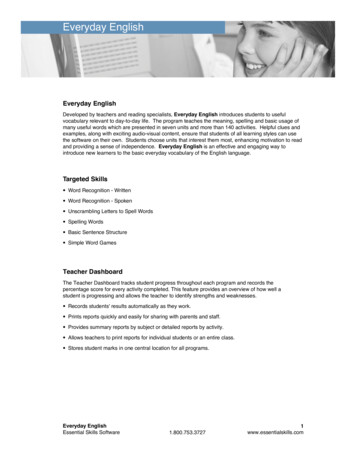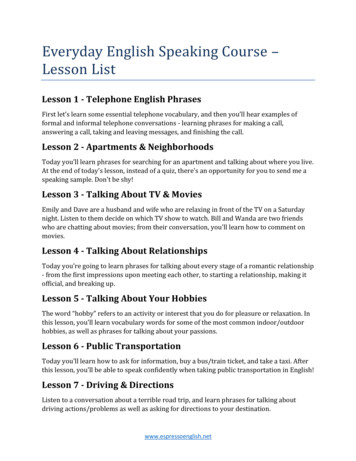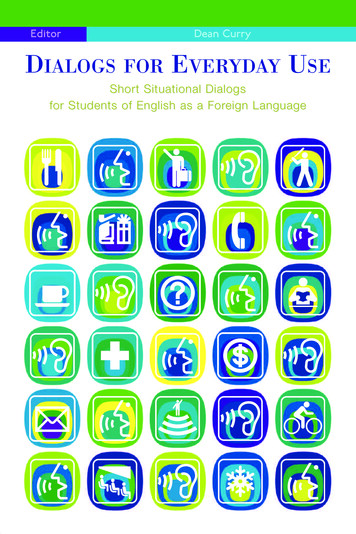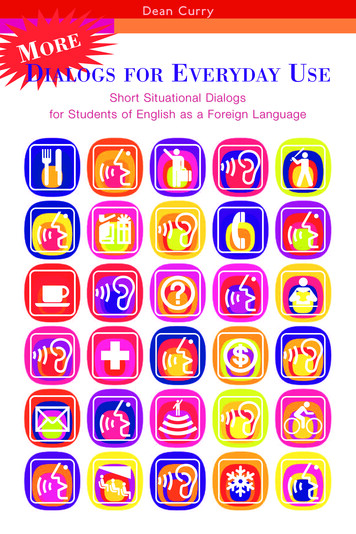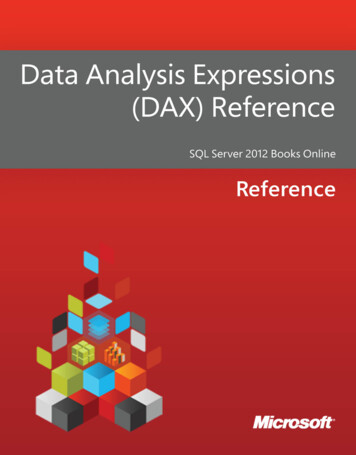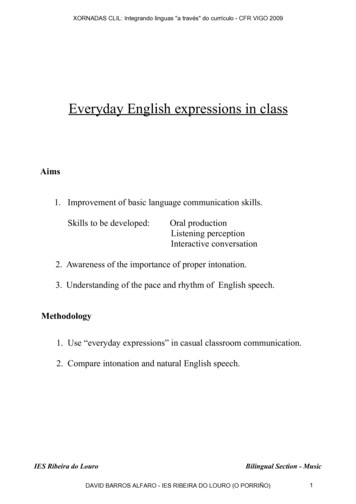
Transcription
XORNADAS CLIL: Integrando linguas "a través" do currículo - CFR VIGO 2009Everyday English expressions in classAims1. Improvement of basic language communication skills.Skills to be developed:Oral productionListening perceptionInteractive conversation2. Awareness of the importance of proper intonation.3. Understanding of the pace and rhythm of English speech.Methodology1. Use “everyday expressions” in casual classroom communication.2. Compare intonation and natural English speech.IES Ribeira do LouroBilingual Section - MusicDAVID BARROS ALFARO - IES RIBEIRA DO LOURO (O PORRIÑO)1
XORNADAS CLIL: Integrando linguas "a través" do currículo - CFR VIGO 2009TEACHERThese expressions are meant to be said naturally and accompanied, if possible, by gestures.The teacher pronunciation should be clear, with the proper pace and rhythm to be understood.Intonation should follow the natural English speech, according to the emphasis of words.The emphasis or stress is the extra force that you give to a word of part of a word when you arepronouncing it.These expressions have to be used in an actual context, not in a contrived one. Based on thisprinciple, both listening and speaking activities are part of a comprehensible system.Most of the time, in order to be understood you have to change the expressions right in the momentIn this case, some tricks are: Tell a synonym. Take this “handout” paper / copy. When explaining opposites give examples: Low / High , Loud / soft , Long / short. Definitions. To clap: to hit both hands together Use body language. Thumbs up for “right” Use a “familiar association” or symbolism.All the expressions are classified as it follows:1. Greetings and farewells.2. Spontaneous reactions3. Getting their attention.4. Telling them to do sth.5. Encouraging expressions6. Organising contents, time and places.7. Showing sympathy8. Checking their understandingIES Ribeira do LouroBilingual Section - MusicDAVID BARROS ALFARO - IES RIBEIRA DO LOURO (O PORRIÑO)2
XORNADAS CLIL: Integrando linguas "a través" do currículo - CFR VIGO 2009Greetings and farewells.Good morning / morningHello / Hi guys!How do you do?GoodbyeBye, have a nice dayEnjoy your daySee you tomorrowTake careSpontaneous reactionsThank youThank you / you're welcomeBless you!CongratulationsDo you feel well?Do you have the hiccups?a headache, stomachache, a cold, the flu, Sorry ( apologize )Sorry? ( say it again )Getting their attentionListen. Look.Pay attention.So now, listen to.Excuse me.Watch out!I have a question for youWhat's up?IES Ribeira do LouroBilingual Section - MusicDAVID BARROS ALFARO - IES RIBEIRA DO LOURO (O PORRIÑO)3
XORNADAS CLIL: Integrando linguas "a través" do currículo - CFR VIGO 2009Telling them to do sth.Take out your notebook/recorder/penWrite down the following sentenceRepeat after me.Can you repeat, please?Please, open your notebook.Check your answers.Work in groups. Work in pairsGet together in groups of fourGo to the digital boardRaise your hand to answer.Read sth. aloudStand up / sit downSpeak louder, pleaseSpeak more slowlyShut up!Stop interrupting/ Don t interruptMemorizeCan you spell it? / How do you spell it?Hold your horses!!Encouraging expressionsRight! / you're rightWell done! / Very well! / GoodGood job / Great jobExcellentFabulousThat's fineBrilliantGo onLet's continueGo aheadIES Ribeira do LouroBilingual Section - MusicDAVID BARROS ALFARO - IES RIBEIRA DO LOURO (O PORRIÑO)4
XORNADAS CLIL: Integrando linguas "a través" do currículo - CFR VIGO 2009Organising contents, time and places.Let's start our class.Today, we are going to.First. and then / next From the beginning of the page.We are going to review the homeworkAny questions so far?Volunteers, please!I'm going to check/count if you're all in the classroom.Who is not here? ( checking roll )What date is it today?What's the date today?Showing sympathyMake it simplerMake it easier.Try againOnce more / once againSay it again.Don't get it, can you repeat, please?What do you mean with.?It s the other way roundUse your brainsRelax!Checking their understandingDo you understand me?Is it clear?What does ( word ) mean?What's the meaning of. ?Is this right? / Is this ok?May I ask. ?How do you say. in English?Tell me the difference between A and BAre you ready?Finish?Any questions so far?Who knows the answer?What else?Does it ring a bell?IES Ribeira do LouroBilingual Section - MusicDAVID BARROS ALFARO - IES RIBEIRA DO LOURO (O PORRIÑO)5
XORNADAS CLIL: Integrando linguas "a través" do currículo - CFR VIGO 2009STUDENTThese expressions are meant to give confidence to the student's communication skills. As a result,expressions should be encouraged within their classroom relationships.One way to stop yourself translating and therefore increase your speed of comprehension andproduction is to learn all your vocabulary without the use of your own language.Accuracy is something to be expected later on, in the meantime intention and will come first.The most common student's expressions are classified as follow:1. Greetings and farewells2. Spontaneous reactions3. Asking for permission4.Asking for helpIES Ribeira do LouroBilingual Section - MusicDAVID BARROS ALFARO - IES RIBEIRA DO LOURO (O PORRIÑO)6
XORNADAS CLIL: Integrando linguas "a través" do currículo - CFR VIGO 2009Greetings and farewells.Good morningHello / Hi teacher!How do you do?GoodbyeHave a nice dayEnjoy your daySee you tomorrowTake careSpontaneous reactionsThank youThank you / you're welcomeBless you!CongratulationsDo you feel well?Do you have the hiccups?a headache, stomachache, a cold, the flu, Sorry ( apologize )Sorry? ( say it again )Asking for permissionCan I go to the toilet?Can I sharpen, please?Can I use a dictionary?Can I borrow a pen/eraser/paper?Can you lend me your pen/eraser/paper?Asking for helpI need help / more time.Sorry?Say it again.I don't get it, can you repeat, please?What do you mean with.?What does ( word ) mean?What's the meaning of. ?Is this right? / Is this ok?May I ask. ?How do you say. in English?Tell me the difference between A and BIES Ribeira do LouroBilingual Section - MusicDAVID BARROS ALFARO - IES RIBEIRA DO LOURO (O PORRIÑO)7
XORNADAS CLIL: Integrando linguas "a través" do currículo - CFR VIGO 2009English intonation tableStudent's task: Try to guess the expressions after listening to the intonation audio file. The writtenexpressions in the first column are not in the correct order. The student has to figure out their actualposition. They should also decide whether the intonation is higher ( H ) or lower ( L ) pitch.The “actual sounds” audio file are meant to check student's answers.Fill in the “actual sounds” gap writting the expressions in the correct order.IntonationPitchActual soundsGreetings and farewellsBye, have a nice day1Enjoy your day2Goodbye3Hi guys!4How do you do?5Morning6See you tomorrow7Take care8Spontaneous reactionsBless you1Congratulations2Do you have a cold?3Do you have a stomachache?4Do you feel well?5Sorry ( apology )6Sorry?7Thank you8Thank you ( back )9You are welcome10Asking for helpHow do you say guitarra in English?1I don't get it, can you repeat, please?2I need help3I need more time4IES Ribeira do LouroBilingual Section - MusicDAVID BARROS ALFARO - IES RIBEIRA DO LOURO (O PORRIÑO)8
XORNADAS CLIL: Integrando linguas "a través" do currículo - CFR VIGO 2009Is it ok?5Is it right?6May I ask?7Say it again?8Tell me the difference between A and B9What do you mean with.10What does conductor mean?11What's the meaning of conductor?12Asking for permissionCan I borrow a pen?1Can I go to the toilet?2Can I sharpen, please?3Can I use a dictionary?4Can you lend me your eraser?5Requirements needed to make this material:Computer: a) Hardware: Soundcard, headphones and microphone.b) Software: Audacity Encoder Lame MP3Audio player. VLCOpenoffice. Writer.IES Ribeira do LouroBilingual Section - MusicDAVID BARROS ALFARO - IES RIBEIRA DO LOURO (O PORRIÑO)9
Intonation should follow the natural English speech, according to the emphasis of words. The emphasis or stress is the extra force that you give to a word of part of a word when you are pronouncing it. These expressions have to be used in an actual context, not in a contrived one. Based on this principle, both listening and speaking activities are part of a comprehensible system. Most of the .


